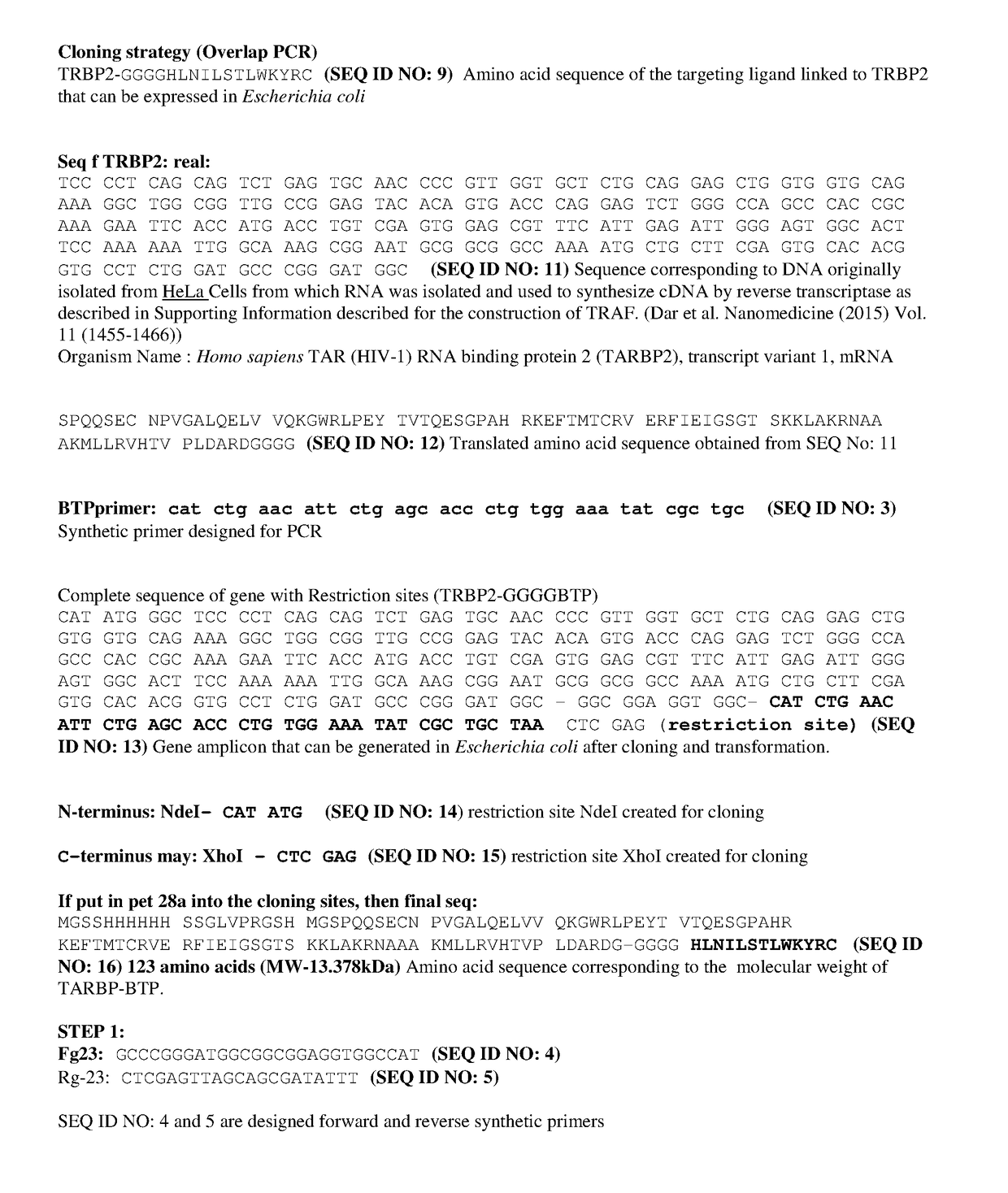Recombinant protein-based method for the delivery of silencer RNA to target the brain
a technology of rna and rna, which is applied in the direction of fusion with rna-binding domain, peptide source, specific cell targeting, etc., can solve the problems of restricted delivery of sirna to brain parenchyma, difficult to achieve specific tissue delivery, and complex structur
- Summary
- Abstract
- Description
- Claims
- Application Information
AI Technical Summary
Benefits of technology
Problems solved by technology
Method used
Image
Examples
example 1
Design, Cloning Strategy by Overlap PCR and DNA Sequencing
[0056]To construct recombinant TARBP-BTP fusion, gene sequence from TRAF corresponding to the second domain (TARBP2 / TRBP2) of the mammalian homolog, a linker sequence encoding five glycine residues and DNA fragment encoding the brain targeting peptide sequence together with a C-terminal cysteine codon was amplified by overlapping PCR. DNA duplexes with and without the targeting ligand were cloned in pET28a plasmid (Novagen) in the NdeI-XhoI site to generate N-terminal 6 His-tagged fusion constructs that were verified by DNA sequencing. The N-terminus-tagged fusion protein TARBP-BTP, a 13.378 kDa with the corresponding DNA and translated protein sequence by EXPASY. TARBP having high affinity to double-stranded RNA (dsRNA) was fused to a ganglioside targeting peptide sequence, originally selected by phage display for GT1b and GM1 binding to deliver siRNA to the brain.
example 2
Purification and Verification of TARBP-BTP
[0057]The selected recombinants were expressed in E. coli BL21(DE3) cells and purified to homogeneity using Ni-NTA affinity chromatography. E. coli BL21(DE3) cells overexpressing the recombinant proteins were lysed under denaturing conditions using lysis buffer (50 mM sodium phosphate buffer pH 7.4 containing 300 mM NaCl, 10 mM Tris, 6 M urea and 1 mM PMSF) followed by sonication. Following centrifugation of the lysate at 18,000 rpm for 20 min to pellet cell debris, the supernatant was incubated with the pre-equilibrated Ni-NTA sepharose matrix for 1 h. The matrix was then loaded onto a column and washed with 0.1% Triton X-114 in lysis buffer at 4° C. to remove the bacterial endotoxins. The matrix bound TARBP-BTP protein was refolded under native conditions by on-column refolding and eluted using sodium phosphate buffer (pH 7.4) containing 300 mM imidazole. The eluted fractions were pooled, desalted and buffer exchanged in phosphate buffered...
example 3
Far UV CD Spectrum
[0058]Far UV CD spectrum (range 250-200 nm) of purified TARBP-BTP (0.1 mg / ml in PBS (pH 7.4) recorded at room temperature using JASCO-J-815 spectropolarimeter equipped with Jasco Peltier-type temperature controller (CDF426S / 15). The secondary structure analysis of TARBP-BTP by CD spectroscopy reveals that the secondary structure of the silencer-binding domain is unaltered. The spectrum, acquired in a 1 cm path length cuvette, was an average of five scans that was corrected for the buffer baseline and plotted using Origin7 software (OriginLabCorp.). Spectra were recorded in ellipticity mode at a scan speed of 50 nm / min, response time of 2 s, bandwidth of 2 nm and data pitch of 0.2 nm. Mean residual ellipticity was calculated as described. Further, far-UV circular dichroism spectroscopy suggested a well-defined secondary structure, consisting of both α-helices and β-pleated sheets similar to earlier observations.
PUM
| Property | Measurement | Unit |
|---|---|---|
| Percent by mole | aaaaa | aaaaa |
| Molar ratio | aaaaa | aaaaa |
Abstract
Description
Claims
Application Information
 Login to View More
Login to View More - R&D
- Intellectual Property
- Life Sciences
- Materials
- Tech Scout
- Unparalleled Data Quality
- Higher Quality Content
- 60% Fewer Hallucinations
Browse by: Latest US Patents, China's latest patents, Technical Efficacy Thesaurus, Application Domain, Technology Topic, Popular Technical Reports.
© 2025 PatSnap. All rights reserved.Legal|Privacy policy|Modern Slavery Act Transparency Statement|Sitemap|About US| Contact US: help@patsnap.com



